A 7 day International Tour together with our friends from Oriole Birding, we headed off to Northern Greece to visit Lake Kerkini and explore the surrounding area. It was lovely sunny weather, blue skies and light winds, although starting to get a little hot in the middle of the day towards the end of our visit.
SUNDAY 29TH APRIL
It was a very early start at London Gatwick this morning, for the 0555 departure to Thessaloniki in Northern Greece. After a slightly delayed start due to the airline boarding some people onto the plane who were meant to be going to Corfu [!] we eventually set off and enjoyed a swift three hour run down, landing only about fifteen minutes behind schedule. The transit through the airport was typically painless, given its small size, and soon we had collected our hire vans and were making our way north towards the south end of Kerkini Lake where we would meet Stergios our hotel proprietor for an al fresco picnic lunch.
While we ate our way through the spread, we were able to scope our first Dalmatian Pelicans, and watch Common Terns, a flock of Mediterranean Gulls and a flyby Night Heron. A second calendar year Caspian Gull was also noted, a nice ‘snouty’ white-headed example, and we could hear our first Golden Orioles and Eastern Olivaceous Warblers signing thereabouts.
From here, we made our way slowly up the western shore of the lake to Korofoudi, and made our first proper birding spot on the flat coastal plain where normally there is a fair bit of exposed mud on the shallow shelving shoreline. However, the heavy late winter snow had clearly now made its way down from the Belles Mountains, and the water levels were actually very high. Nevertheless, a flock of 26 Wood Sandpipers came up from the shore as we parked, and proceeded to pick their way through the flooded grass at the lake edge – fantastic!
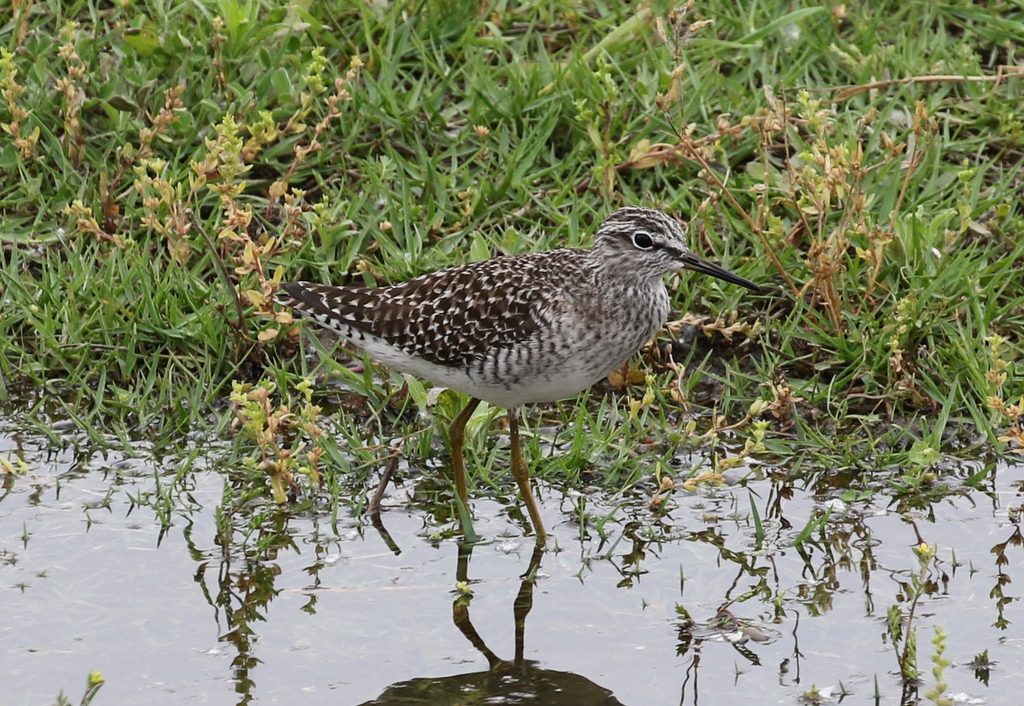
A tiny patch of reeds held no less than three Great Reed Warblers, croaking away from the very tops of the reed heads in full view. We also enjoyed the many Spanish Sparrows here, with the dapper males collecting the heads of the phragmites and carrying them to a nearby White Stork nest. The storks themselves were down in the roadside meadow foraging, and here we also found a fine male Red-backed Shrike, Corn Bunting and two flyby European Bee-eaters.

This whole area was just hooching with great birds and it was difficult to know where to look first! Our first Pygmy Cormorant of the trip showed really well, and a cracking adult Eurasian Spoonbill flew in and began feeding right next to the road in a small pool.
Perhaps the best birds seen in this area though, despite them being rather distant, were a pair of Levant Sparrowhawks displaying above the wooded ridge behind us. The incredible mechanical, super-slow wingbeats of the male were quite unlike any other accipiter display, even if the more familiar switch-back routine followed it. We could just about make out the dark wingtips too, but the distinctive shape with a narrow, pointed ‘hand’ were clear to see. Heading north, we had a few more good roadside birds, in particular our first Black-headed Bunting of the trip perched on some roadside wires, but also Woodchat Shrike, Red-rumped Swallow and Black Kite, before reaching our hotel in the foothills just north of the lake.
After a quick check in, we were keen to head straight back into the field to make the most of the fantastic light and warm evening temperatures, and so we made straight for the small harbour at Mandraki. This site really comes into its own late in the day, and we enjoyed another veritable feast of wetland birds here. Squacco Herons stood among the lily pads, part of a list of seven heron species that included many Great White Egrets, single Cattle Egret, a few Night Herons and three smart Purple Herons. The light was so great, and the birds were mainly fairly close – the Squacco Herons especially looked stunning as they flew past us, perfectly reflected in the still water.
We could see the artificial pelican nesting islands in the distance and as well as the many Dalmatian Pelicans, we could easily pick out the salmon pink White Pelicans too! Over the water, among the many Common Terns, two Whiskered Terns were dip feeding and we were greeted with the quite remarkable sight of at least two hundred Great Crested Grebes nesting colonially in the shallows to the west of the harbour – unreal!
Other species noted here included a scoped Common Cuckoo, two Red-rumped Swallows, and a young Goshawk which drifted through mobbed by Hooded Crows. Two drake Garganey and a Black-winged Stilt were also seen distantly out towards the drowned forest, an area we would explore more thoroughly in the coming days from a specially arranged boat trip. Only day one, and already we were getting the feel for why Kerkini is such an awesome birding destination.
MONDAY 30TH APRIL
Our first full day was spent largely around the north-east side of the lake, birding around Vironia and Megalachori and enjoying the feast of waterbirds on offer. But before breakfast, we took a short drive up the hill behind the village to check out a Semi-collared Flycatcher which had been found by Paul and the previous group out here last week.
The bird was still singing in exactly the same spot, and presumably this was in fact a potential breeding location, as the mature plane trees along a stream looked ideal habitat for sure. We soon found the Semi-collared Flycatcher, a fine male [though perhaps a first summer due to its slightly brown flight feathers and restricted white in primary bases], and over the next half hour we played cat and mouse with it in the canopy above. The bird was singing and calling virtually non-stop, but was very mobile and didn’t remain on the same perch for long. Eventually though, everyone had a great view through the scope. Just as we were about to head back for breakfast, we realised there were in fact two males present! A great result and perhaps one for future trips too.
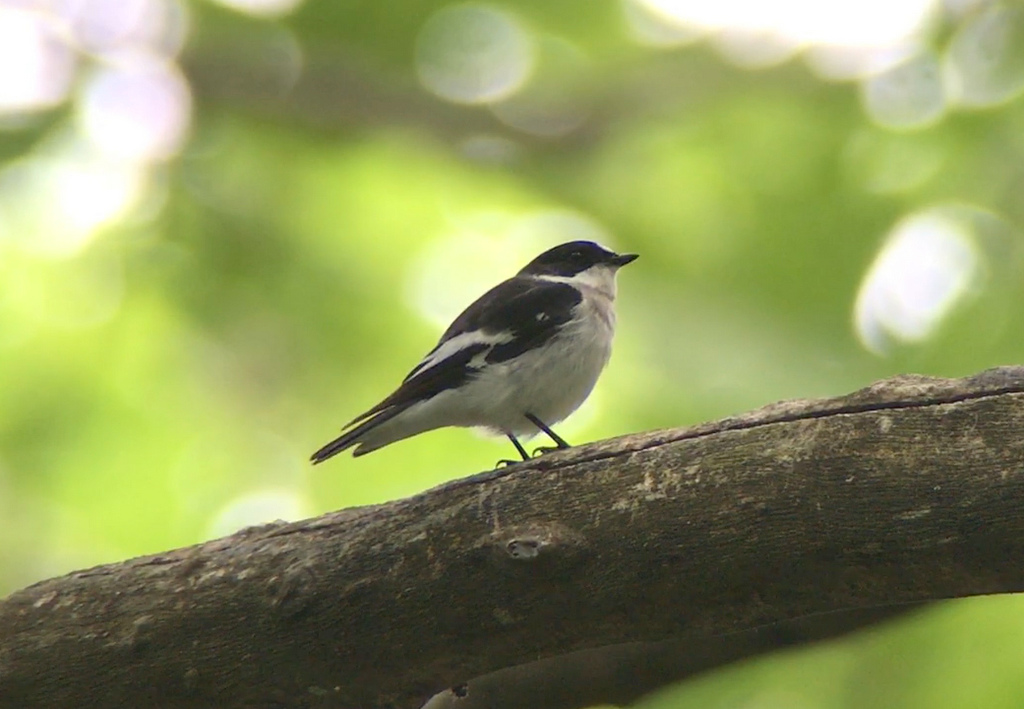
After breakfast, we set off down the hill towards the main road, stopping at one of our favourite spots for migrants by a water trough just outside the village. This proved to be a brilliant area this morning, with a great variety of migrants and summer breeders noted. Golden Orioles were calling from the Plane trees all around, and eventually we had great scope views of a male. There were Corn Buntings jangling, Turtle Doves purring, and Red-rumped Swallows perched on the wires above.
In the meadows around the drinking trough we found Woodchat Shrike, Common Nightingale, Common Whitethroat and Eastern Olivaceous Warbler [seen well!] and overhead we had a fairly distant Goshawk being seen off by a Hooded Crow. Our second Black-headed Bunting of the trip, another singing male, was perched up on a roadside bush and a couple of European Bee-eaters flew north – we had seen a flock of twenty or so going high north towards the mountains earlier on. Perhaps the best bird here was a cracking Eastern Orphean Warbler which was singing quietly and seemed to be nest building in the bushes in the meadow – it never quite sat fully out in the open, but we managed to piece together some decent views of it.
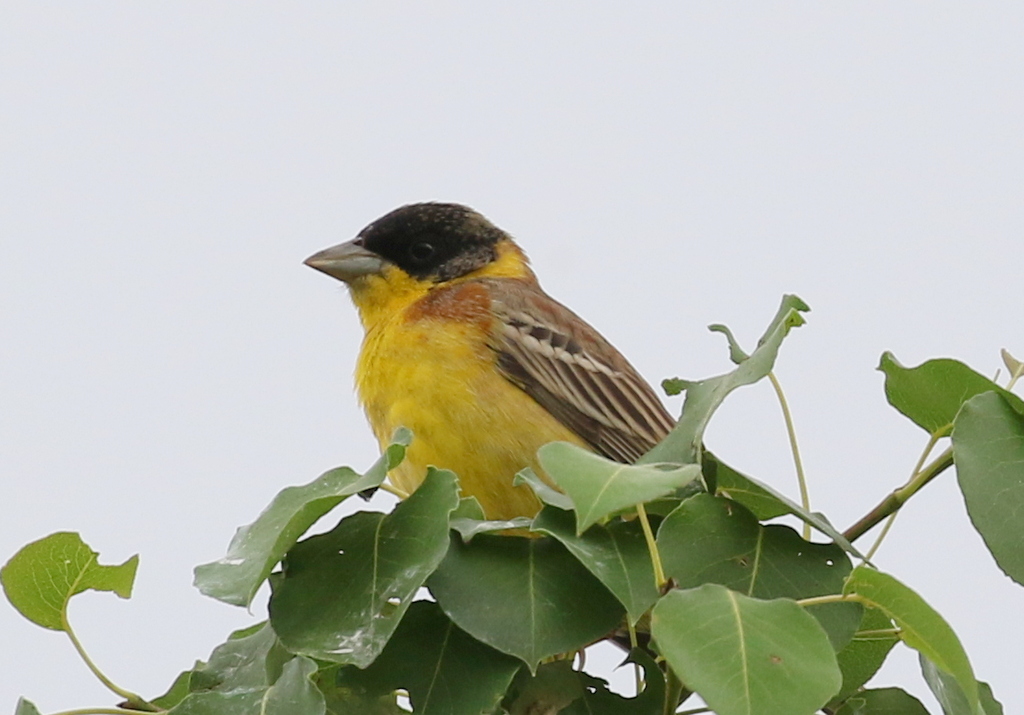
Just as we were about to get back into the vehicles, a Tree Pipit dropped in and began walking around in a muddy puddle next to the trough, and a male Cirl Bunting popped up in a roadside bush – just brilliant. As we drove away, a stunning male Red-backed Shrike landed on the fence by the side of the vehicles with a large beetle, so close we could almost reach out and touch it. We hadn’t even got to our first proper birding spot for the morning yet!
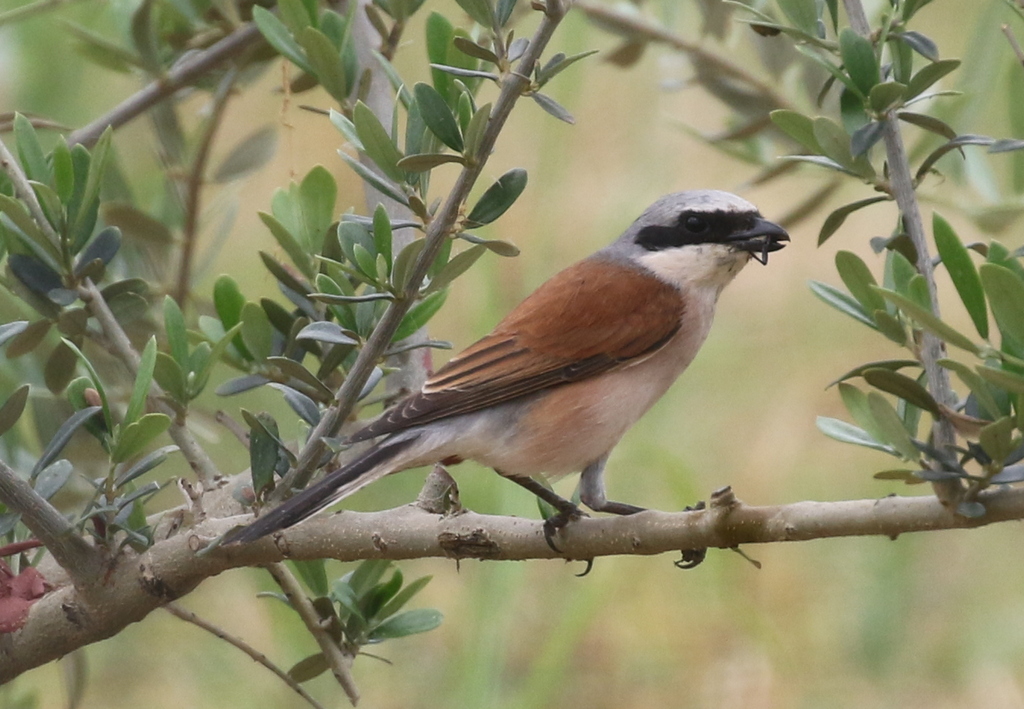
Vironia tracks was next on the agenda, and we enjoyed walking slowly along beneath the cool shade of the trees. There were lots of insects on the wing, and we had great views of Green-eyed Hawker and Scarce Chaser dragonflies, and as things warmed up a little more, we had a great selection of butterflies including Eastern Festoon, Green Hairstreak and Grizzled Skipper.
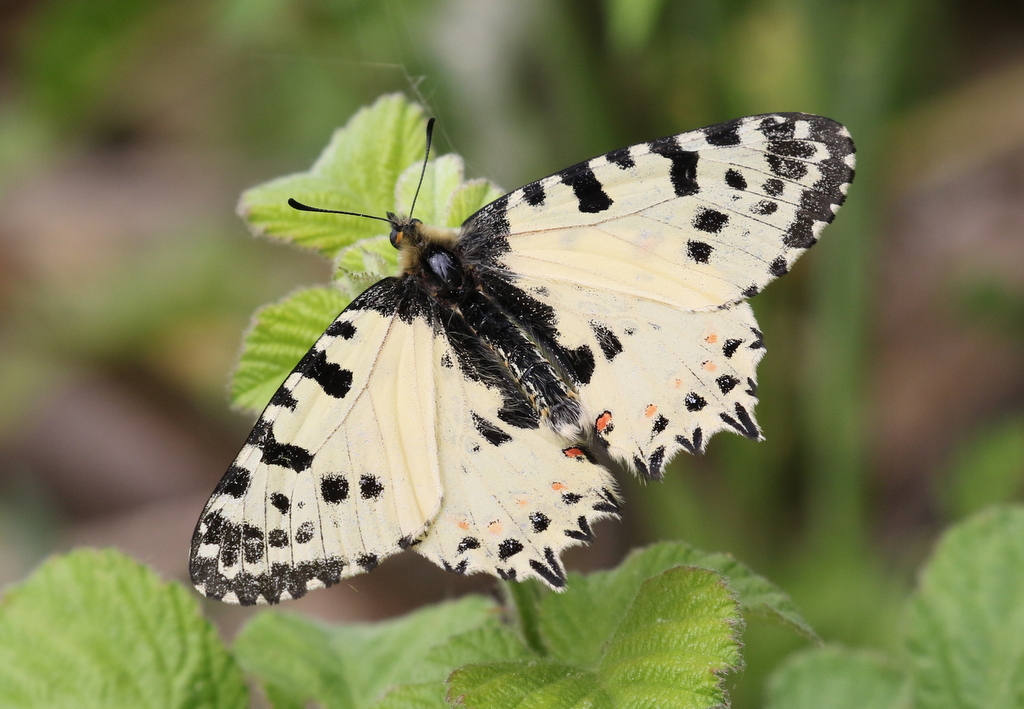
Not to be outdone, the birds performed too, with particularly excellent views of Levant Sparrowhawks, which seemed to be setting up territory close by. After several close but obscured glimpses of them among the trees, we had the male perched in the open feeding on prey, and later had him flying above the fields – very distinctive looking birds.
Other notable sightings here included Syrian Woodpecker, and a fleeting Grey-headed Woodpecker which refused to perch for us. More obliging was a fine Lesser Spotted Eagle sitting on a dead tree, and our first Black Stork drifting in low over the bushes. Common Nightingales were belting out their song all along this stretch, and we even saw one or two of them! Back at the vehicles, Common Cuckoo and Red-backed Shrike were seen – not a bad morning so far.
Coffee and lunch became combined into one stop today, at the gazebo by the River Strimon bridge. This was an excellent location for getting views of the many European Bee-eaters present, with the birds landing on the ground all around us, and sitting on the trees and wires. A Hoopoe tried its best to out-do them, calling in beautiful light from an exposed perch. Sand Martins were also buzzing all around us, and we had some nice fly-bys from Dalmatian Pelican and Pygmy Cormorant.
The afternoon would be spent winding our way slowly along the eastern embankment of Lake Kerkini, birding as we went, and so we started at the pool just beyond Megalachori where we soon found our first Little Bitterns of the trip – a male and female skulking deep in the edge of the reeds. We scanned hard for crakes, but found two families of Coypu instead! As the day began to really warm up, so the raptor activity increased as well – at least three Lesser Spotted Eagles displaying above the mountain ridge, and a group of three Levant Sparrowhawks migrating high and distant.
Back down at ground level, an absolutely superb male Golden Oriole perched in the open for us, signing from the open canopy of a poplar, before chasing the female off down the wooded gulley next to the embankment. We went on to get several more views of them during the afternoon, and of course we could hear them [and the Nightingales!] as an almost constant soundtrack.
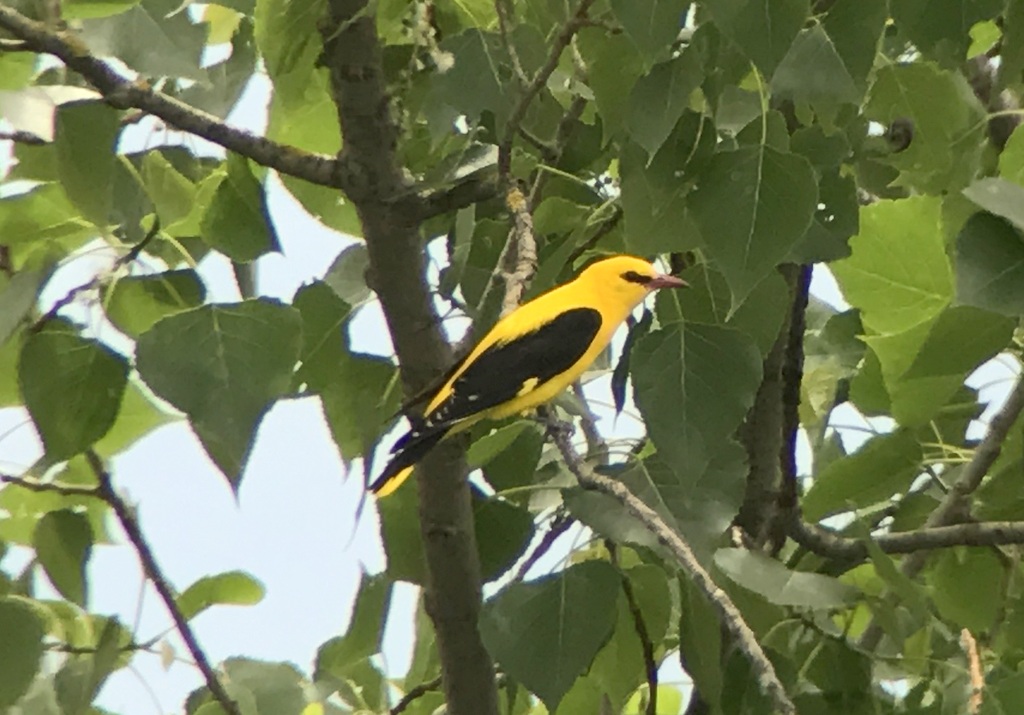
Moving further south along the bank, we had perhaps our best birding of the day looking out across the north-east corner of the lake – the light was superb, the weather beautiful and the place was stuffed with great birds! We passed a flock of Spoonbills busy feeding in a shallow pool, accompanied by several Little Egrets which lurked around the edge of the group, presumably watching for any escaping prey.
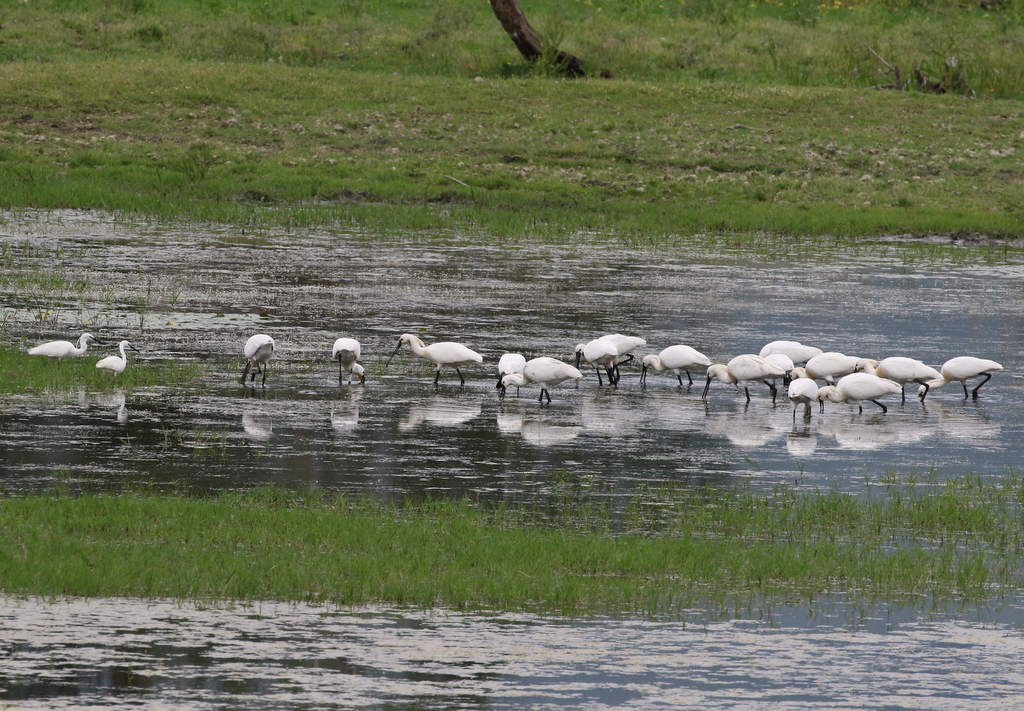
Dalmatian Pelicans were resting on the small exposed islands, where groups of Ruff, Wood Sandpipers, Common Greenshank, Black-winged Stilt and Little Stints were feeding. We found a lovely pair of Gull-billed Terns, a party of Glossy Ibis, and the shallow water was littered with herons, grebes and cormorants. On one exposed patch of flotsam, were two Night Herons, a Squacco Heron and Purple Heron together! In fact there were scores of Squacco Herons here, and everytime we scanned across the marsh we would pick out something else of interest.
Shoveler, Gadwall, Wigeon, a flock of thirty Whiskered Terns, a feeding frenzy of White Pelicans and two perched adult White-tailed Eagles! The very interesting eastern race of Greylag Goose [rubirostris] was not championed by everyone, however!
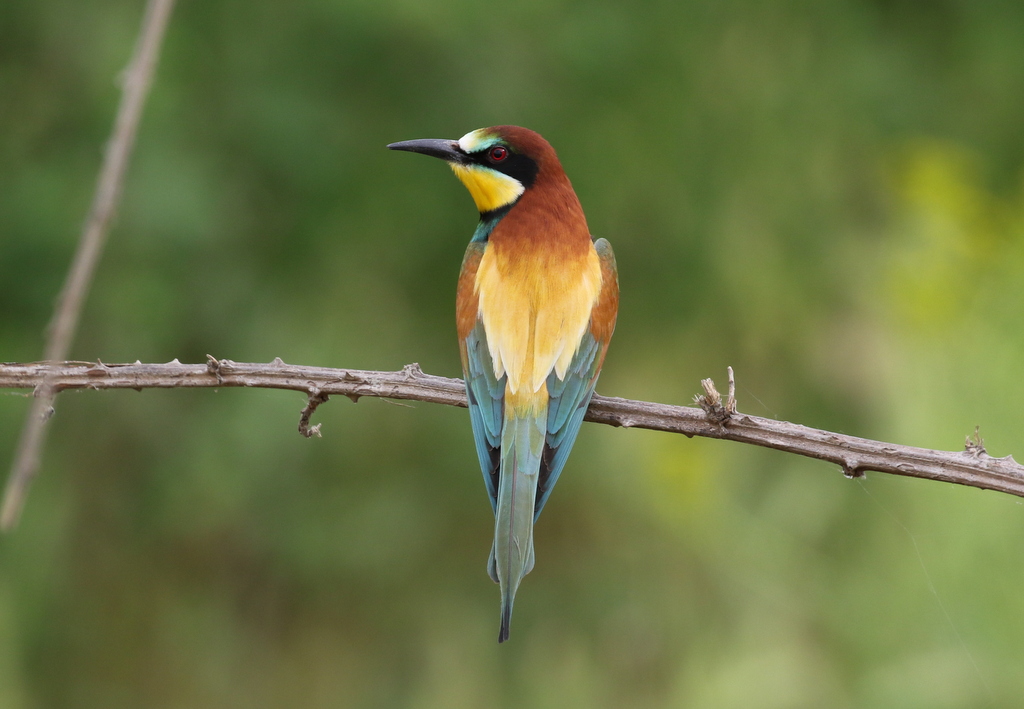
Tearing ourselves away from this amazing spot, we drove very slowly south along the bank birding as we went. The views of Bee-eaters along here were just amazing, and some of the group saw a Lesser Spotted Woodpecker and Spotted Flycatcher briefly. More obliging, and a perfect way to end the day, was a nest building pair of Penduline Tits which entertained us for quite some time. We had heard dozens of them during the day, but they had all remained frustratingly elusive until now – fantastic views of the pair hard at work!
From here we wound our way back through the villages off the east embankment, picking up lovely roadside views of Black-headed Wagtail, and a White Storks nest busting with three species of sparrow. It was amazing how quickly the day had passed – time certainly flies when you’re having fun!
TUESDAY 1ST MAY
It was certainly a lot warmer out today, with the hazy cloud from previous days burning away to reveal clear blue skies and subsequent rising temperatures. We started our day again at our adopted local patch, by the water trough at the edge of Ano Poroia village. We were greeted again by Woodchat and Red-backed Shrikes, though there had been an obvious increase in the latter species overnight with at least four present. Golden Orioles could be heard calling around and we saw a stunning male flying around a couple of times, while we also had more views of Eastern Olivaceous Warbler and Cirl Bunting.
While watching one of the shrikes, a bulky bird popped up next to it in the same bush – a spring plumaged Barred Warbler! This was a new plumage for many of the group, and an exciting sighting for the leaders too! We could see its orange eye, as it began singing right out in the open next to the male Red-backed Shrike – stunning! Despite seeing many juveniles in autumn back in the UK, we never get to see them in this plumage in spring so this was a real treat.
Just when we though we had experienced the highlight of the morning, a pair of Levant Sparrowhawks flew low along the road and right past us, before both began to circle above the road. The male started to display literally over our heads, encouraging a second male to fly in and tussle with him! The two males chased each other into the trees, calling as they went, leaving the female circling above.
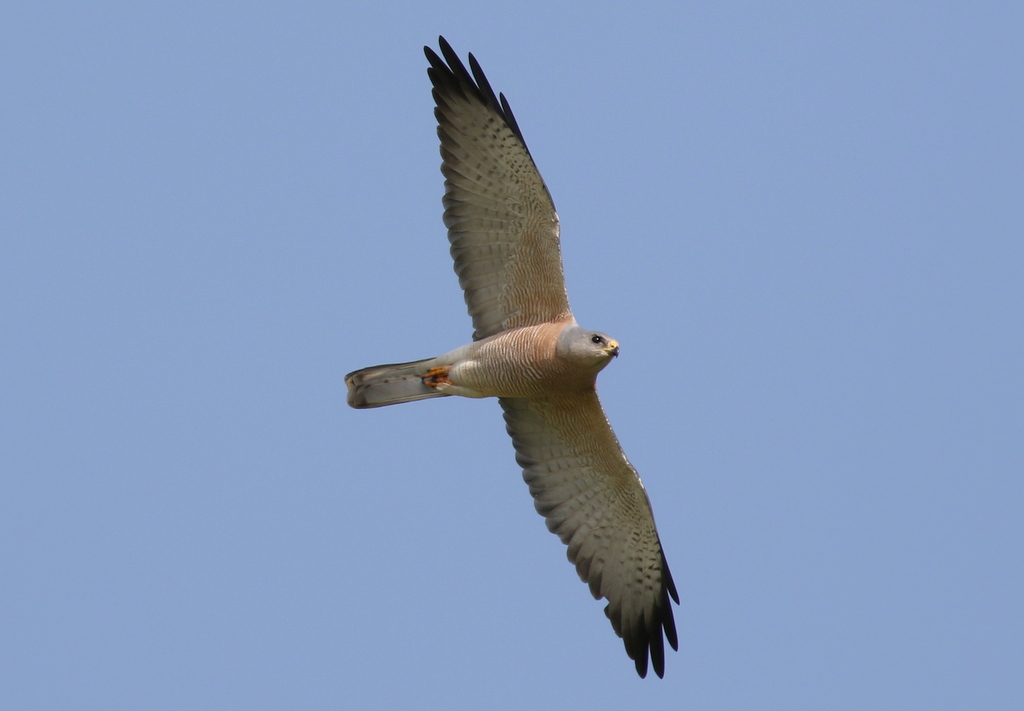
This cycle was repeated several times, and in the crisp morning light the cameras among the group were rattling away as the birds passed only a few metres above us at times. It was even possible to see the diagnostic dark gular stripe on the throat! One of the males retired victorious to the nearby plane trees, where we were able to watch it perched in the open through the scopes. What a fantastic experience!
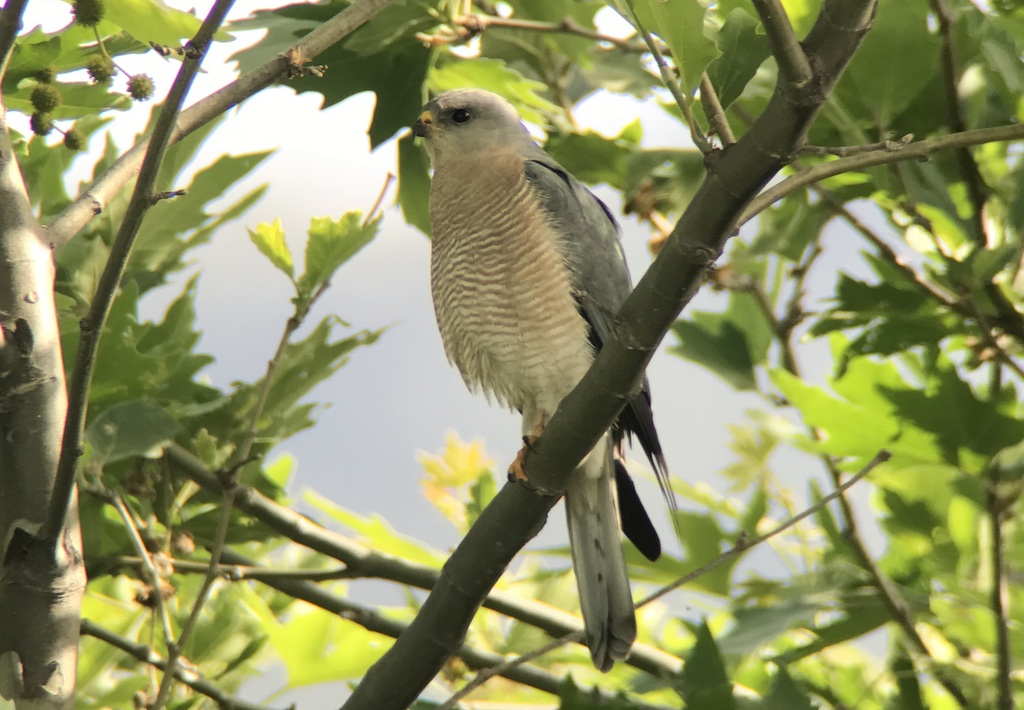
Next we headed for Sidirokastro, to the east of Lake Kerkini, to try for one or two specialities of rocky hillside habitats. It was already very hot here, and many butterflies were on the wing – Scarce Swallowtail, Small Blue and many fritillaries. Bird wise it was a little quiet, though we noted our first Short-toed Eagle soaring, and there were some lovely Eastern Black-eared Wheatears flitting around the Byzantine castle ruins. Our quest for Western Rock Nuthatch sadly proved fruitless, and we had to make do with a Blue Rock Thrush instead. Coffee and cake in the shade of the pines by the parking area, was most welcome afterwards.
Having failed with the nuthatch here, we opted to try another site just a couple of miles away – a large quarry set up in the hillside north of Sidirokastro. This proved to be an outstanding site. First up was a Long-legged Buzzard over the parking spot, and despite being rather against the light the bird could be identified by its long wings, plain underwing coverts with contrasting black carpal patches, uniform underparts and very pale head.

The buzzard gained height, and soon we could see why – a large, all dark eagle was drifting low straight towards us! The bird passed directly over our heads, and we thought it was probably a Golden Eagle at first. We had niggling doubts though, mainly due to its fairly short tailed silhouette, and broad hand. We thought we could see a pale window in the primaries, too. The views themselves were inconclusive, but the photos were very instructive and also showed a pale cream shawl to the nape isolating a dark eye, broad based wings due to long secondaries, paler tail base and long sixth primary – it was an Eastern Imperial Eagle!! This was quite a discovery, being the first ever record of the species on our tours here.

The quarry itself was equally brilliant – a Western Rock Nuthatch was singing, its loud call resonating around the quarry. We also found its mud nest being constructed in a crevice in the rock face, and so we had some superb prolonged views. Also in the quarry were two singing Ortolan Buntings, a pair of Black Redstarts, Blue Rock Thrush and both male and female Eastern Black-eared Wheatears. Absolutely fantastic birding!
Next we had a long drive down to Serres, and after negotiating our way through the town, we took the winding mountain road up to Vrontou and the Laillas ski centre. Our lunch stop was about 4 miles before the summit, in beautiful open hillside with scattered juniper and rocky scree. We didn’t see too many birds here, though some of the group noted a Woodlark and two more Short-toed Eagles were seen.
Reaching the ski centre, we explored the beautiful beech woodland near the summit, adding Mistle Thrush, Spotted Flycatcher, Blackcap, Common Chiffchaff, Coal Tit and Marsh Tit. We couldn’t find any Black Woodpeckers today though, despite a good search.
Time was ticking away from us, so we headed a short way back down the mountain and tried another track through mature pines to a viewpoint. Two Tree Pipits flushed from the path into the trees, and we had Common Ravens displaying overhead. Crested Tit showed particularly well, even allowing everyone a view in the scope, while a Rock Bunting was more furtive and made us work hard to even get half the group a view. An Eastern Subalpine Warbler singing from the pines was our first of the trip, and another new sylvia was seen in the form of a pair of Lesser Whitethroats.
Back at the vans we had a coffee, to perk us up for the final push of the day! This would be a short stop on the way back to base, to check a site for European Roller. Thankfully the birds had read the script – at least one of them had anyway – and we enjoyed lovely views of a single bird perched on wires above the track in the evening light. It flew down to the field edge a couple of times, flashing its brilliant blue and purple wings and tail as it looped back up to its perch. A perfect way to end a long but rewarding day.

WEDNESDAY 2ND MAY
The warmest day of the tour so far saw us head up to the Bulgarian border this morning at Promachonas. On the way, we picked up another European Roller perched on roadside wires, looking dazzling in the morning light as it flew down to the ground. Once at the so called ‘woodpecker wood’ we made our way down to the river and slowly along listening for any calls or activity of woodpeckers generally. This was met with mixed success – we heard a Lesser Spotted Woodpecker calling as soon as we arrived, but otherwise the only activity noted was from Great-spotted Woodpeckers which were pretty common.
Feeling a little frustrated and being nibbled by mosquitoes, we headed back and tried going east along the trail a little bit. Here in a small clearing, a black and white woodpecker flew low past us and perched on the side of a big poplar trunk – it was a Middle Spotted Woodpecker. This was our main target species here, and we managed to get about half the group a scope view before it quickly made off into the trees.

We tried walking along the road a bit to relocate it, but without any joy. We did see a Green Woodpecker though, and then two shrikes flew over calling showing lot of white in the wings. One perched in the canopy above us briefly – a female Masked Shrike. The male seemed to fly across the road to a small quarry, so we wandered in for a look. Sure enough we found the male Masked Shrike, and had some decent perched views though he was rather skittish.
As we walked back down to the vans, two large raptors circled into view above the Bulgarian border – two European Honey Buzzards, one dark phase and one very pale bird. It was great to see their distinctive flat-winged silhouette and see them lazily flexing the hand of the wing as they circled around a few times before continuing their migration northwards. It had been a productive stop, even if the woodpecker activity had been a bit less than hoped for. After coffee and homemade pizza in the sunshine, it was time to return to the lake area.
Vironia Quarry would be our next stop, a really nice area of streamside plane trees and open scrubby hillside with lovely views south over the lake. It was really hot here, and we failed in our attempt to find any Sombre Tits. We did, however, get fantastic views of a singing Eastern Orphean Warbler, several Eastern Black-eared Wheatears and Crag Martins nesting in the quarry.
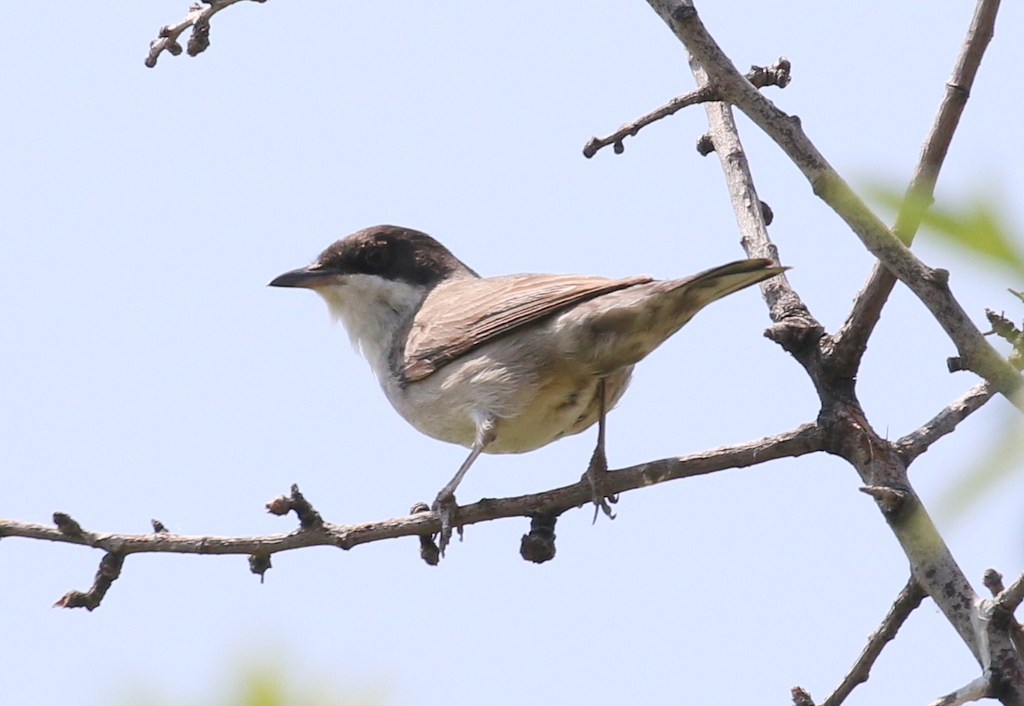
An old Rock Nuthatch nest seemed to have been taken over by sparrows, and there was no sign of the nuthatch, so it was a good job we had secured good views yesterday. Also around the quarry, a male Eastern Subalpine Warbler showed well, and as we began to make our way back out, a Golden Eagle appeared above the ridge and circled round a few times before disappearing over the top. A great comparison with yesterdays Eastern Imperial! Lunch was had in the shade of the trees by the chapel, and in the company of a pair of Syrian Woodpeckers – a very pleasant morning indeed.
The afternoon would be taken up by our boat trip onto Lake Kerkini, always one of the tour highlights. We met Nikos, our ‘captain’, at Kerkini harbour, and set off towards the northern shore of the lake where the best of the action would be. As we approached the mouth of the Strimon, two stunning adult White-winged Black Terns were seen perched quite close to the boat, before they took flight over the mirror flat water in which they were perfectly reflected.
Several Black-necked Grebes dotted the water in full breeding plumage, and now we began to approach the river mouth, we could see a LOT of pelicans ahead! The numbers of White Pelicans were most impressive, and my goodness what plumage they were in! To be so close to such large numbers of these spectacular birds was quite something.

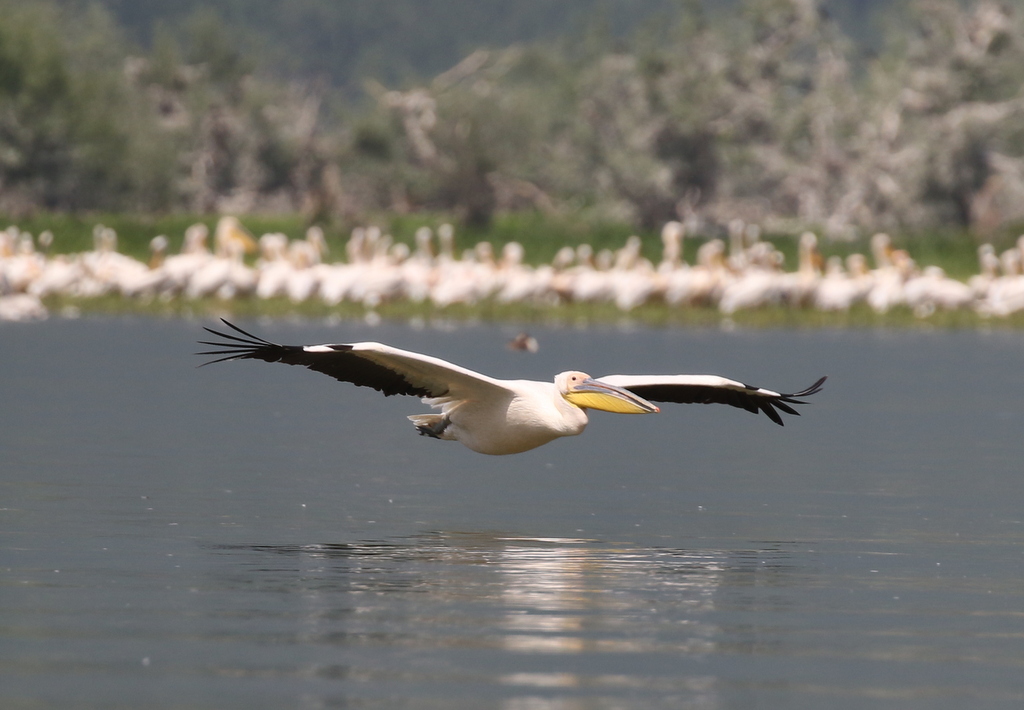
We saw plenty of Dalmatian Pelicans too of course, though they loom somewhat less striking now their breeding season is reaching its finale. Other birds noted here included Eurasian Spoonbills, Black-winged Stilts and a first-summer Caspian Gull.

Nikos then took us through the shallow water towards the drowned forest, and here we caught up with the White-winged Black Terns again, but now there were four or five of them, mixed with a party of Black Terns. Nikos cut the engine and we floated among them, as they danced over the water incredibly close. One of the White-winged Black Terns actually swooped in and grabbed a morsel from the water surface, right beside the boat – amazing! As the flock became more distant, we noticed that they had now been joined by three Collared Pratincoles, as the whole group moved out towards the main body of the lake. A first-summer Little Gull also passed by at close range – we did not know where to look next!

As we entered the drowned forest, so the sound and smell of breeding cormorants and herons became ever more apparent. What unfolded was quite a spectacle, as we floated among the thousands of nesting pairs of Great Cormorant. There were a few pairs of Pygmy Cormorant too, although they seemed to be a lot more wary of the boat.


Little Egrets, Night Herons, Squacco Herons and Spoonbills were all nesting too and seen at point blank range. The views of these birds really were very special indeed.
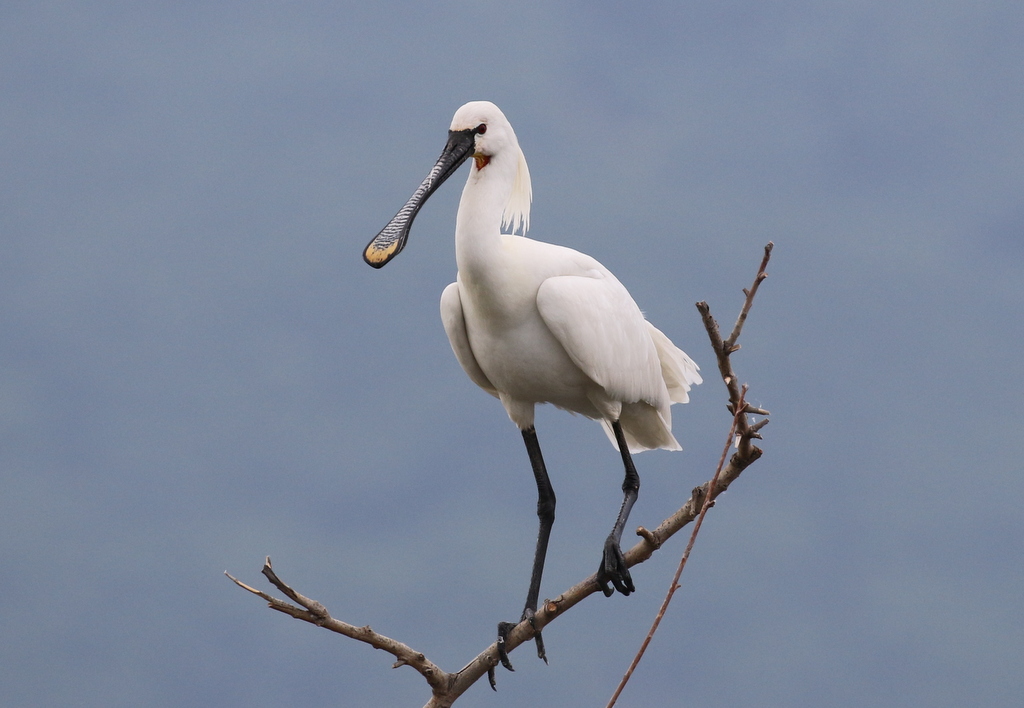
Every now and then we would drift right underneath a stonking pair of Spoonbills, or see a Squacco Heron with bright blue bill base and red legs, standing motionless at touching distance.
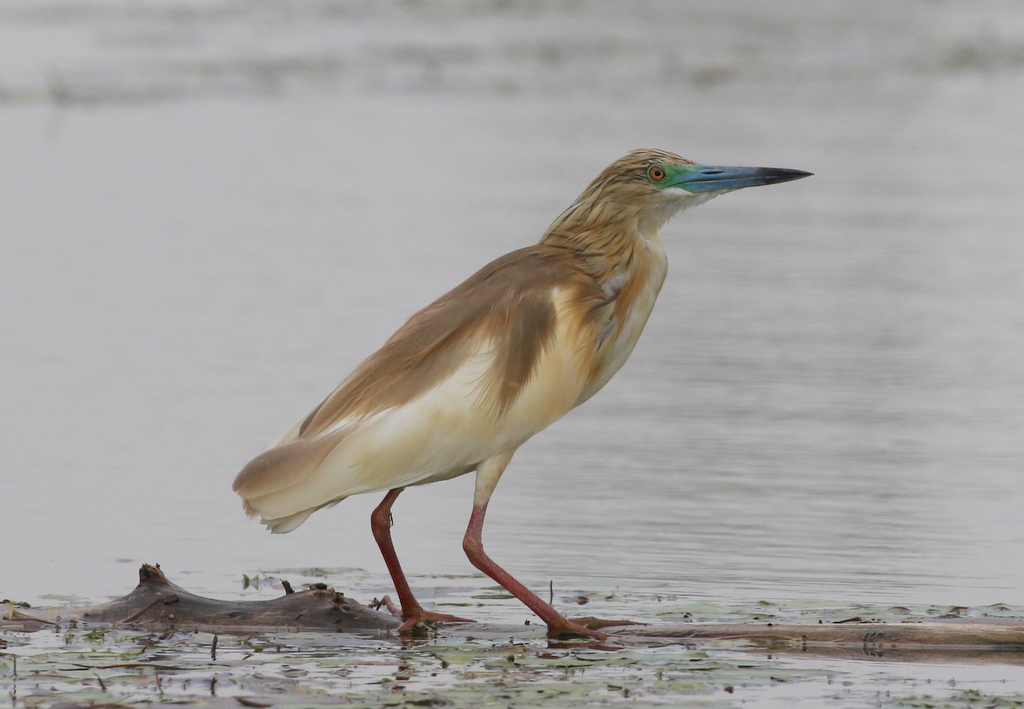
The Night Herons were a favourite though, especially when we got to see their crown feathers raised into a crest and their long white nape plumes erect – totally stunning birds.
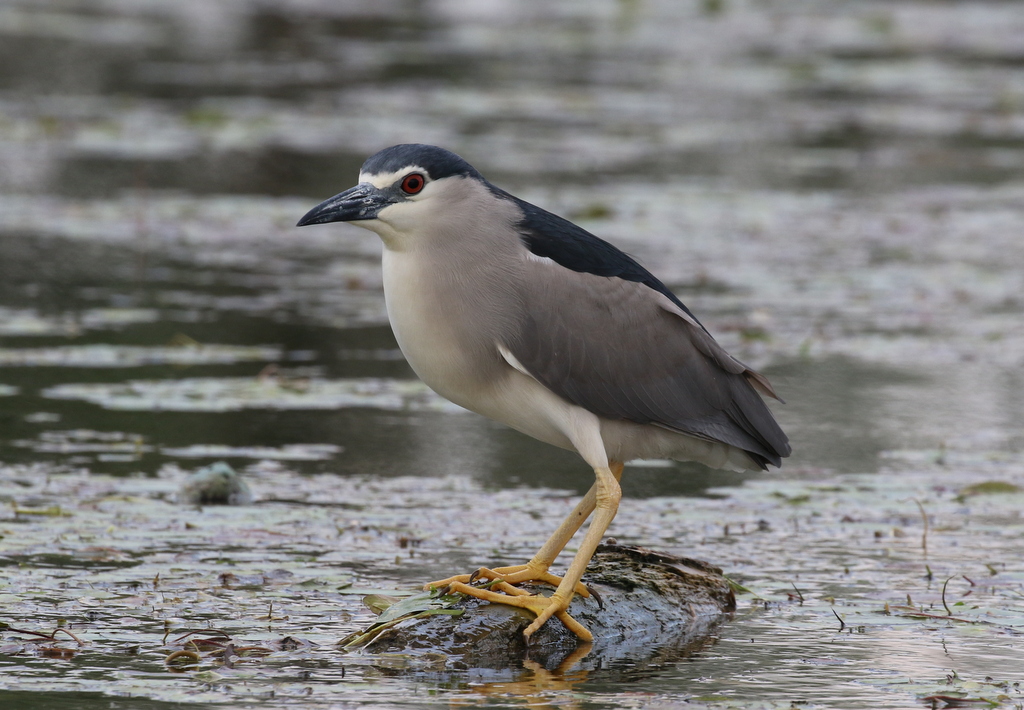
More pelicans next as we glided across to the artificial nesting islands occupied by both species. The White Pelicans are now nesting in good numbers, having colonised in 2016, and the Dalmatian Pelicans [nesting earlier and having large chicks now] were sticking to their favoured wooden platforms. After enjoying these birds close up, we motored back across the lake to Kerkini harbour. A thunderstorm was just breaking over the hills west of the village as we arrived back, and we drove back to the hotel in the rain – we had been very lucky.

After an early dinner, we returned to an area near Kerkini village to try for Eagle Owl, a species always high on everyone’s wants lists. We had plenty of time on the way for a bit of birding, and after a rooftop Little Owl the next highlight was a party of European Bee-eaters, perched on roadside wires in beautiful soft evening light. We pulled up alongside them, and then noticed that several were dropping onto the road in front of us. They were picking delicately at the surface of the tarmac, and we couldn’t quite work out what they were doing – perhaps feeding on ants or other small insects? None of us had seen this behaviour before. Meanwhile up on the wires, there were now a dozen or more Bee-eaters gathered and we could hear them calling and see them displaying with fanned tails quivering and wings arched upwards. Just stunning birds!
With another ten minutes to spare before we needed to start looking for the owls, we decided to stop briefly at Korofoudi marshes. A Black Stork was feeding with a Spoonbill by the roadside, and flew to the edge of the lake, and there were some Dalmatian Pelicans fishing close inshore. One of the Great Reed Warblers was in the small reedbed again, and a superb male Golden Oriole flew down and landed in the roadside bushes where it eventually dropped down out of view.
Back at the owl spot, we had Common Nightingale, Woodchat Shrike, Cirl Bunting and Eastern Olivaceous Warbler before dusk fell, and two or three hoots from the Eagle Owl up on the cliff. We saw it in flight briefly, but unfortunately most people weren’t able to get onto it. Brief glimpses of European Nightjar and Tawny Owl on the way back, and a Eurasian Scop’s Owl calling, were the last action of a long day.
THURSDAY 3RD MAY
What. A. Day! Our trip down to the Axios Delta area west of Thessaloniki is always something of a trip highlight, offering saline lagoons and coastal marshes and of course, lots of migrant wading birds, gulls and terns. We opted to start at the Kalachori lagoon end, which was about one hour twenty minutes drive south from our base, and we arrived at our first stop at the edge of the saltmarsh, to be greeted by three Stone Curlews standing sentinel among the samphire. In the same area, looking east towards the main lagoon, we found our first Lesser Grey Shrike of the trip in the coastal tamarisks, a bird we were beginning to wonder whether or not we would see on the trip at all.
Moving around onto the coastal track, we reached the main lagoon complete with its flock of two hundred or so Greater Flamingoes, still lingering into the breeding season. Despite being mainly young birds, there were still a few gorgeous adults present too, normally having left for the Mediterranean breeding colonies by now.
Also on these pools were a great deal of small waders, and in the excellent morning light we enjoyed some superb and educational views of flocks of gorgeous Curlew Sandpipers and Little Stints and a few Dunlin, Ruff and Turnstone admixed. There were Common and Wood Sandpipers too, and several Little Terns resting on the islands close to the cycle path which bisects the two main pools.
We were able to get really close to the waders here, and this enabled us to pick out two Temminck’s Stints, feeding furtively at the edge in typical fashion. One was a striking rusty toned individual, but both showed the typical yellow legs and randomly dark centred scapular feathers on the back. We were close enough to hear their delicate trilling call too, and see the wholly white outer tail in flight.
Further down, we could see a very impressive flock of about two hundred Spotted Redshanks, with a few Common Greenshanks mixed in, and we found both Common Ringed and Kentish Plovers on the open sandy areas. Once again a highlight, a group of seven stunning White-winged Black Terns were hawking over the water right alongside the path – it was very hard not to be totally distracted by these dazzling birds, but there were a lot of small waders to look through!
After a coffee break, we continued to the far end of the main lagoon, as we had been able to pick out a couple of very distant Marsh Sandpipers and wanted to get some better views if possible. We found a spot where the birds were a bit closer, and we also had them feeding alongside Common Greenshank for comparison. Six birds at least altogether, but perhaps not as stunning as the huge flock of Spotted Redshanks which we could now see at much closer range.
A first-summer Little Gull was floating on the water just below us, and we also saw some nice Black-winged Stilts, Avocets and a couple of drake Garganey from this vantage point before it was time to move on. Taking the track west, we crossed the causeway and over the sluice, heading south and following the coast towards the fishing huts. A Northern Wheatear was feeding on a sandy area next to the track, a late migrant on its way north.

We paused by a small area of enclosed saline pools at the edge of the bay, to look at some close Pygmy Cormorants and our first Common Redshanks of the trip, when we noticed a medium sized plover feeding on the mud close by. First impressions were of perhaps a Grey Plover, but this was quickly dismissed by the birds small size and lightweight bill, and the presence of some yellow in the scapulars and tertials.
It was clearly a Golden Plover of some sort, but right away the alarm bells were ringing as this did not look like a European! Its grey appearance was of course the first anomalous feature, but it showed a small head, very long legs but a short primary projection. Its head pattern was also interesting, as it showed a fairly distinct supercilium, pale spot on the ear coverts and dark cap – though these features were not as contrasting as one would expect on an American. The penny was dropping, this looked every inch like a Pacific Golden Plover in first summer plumage!
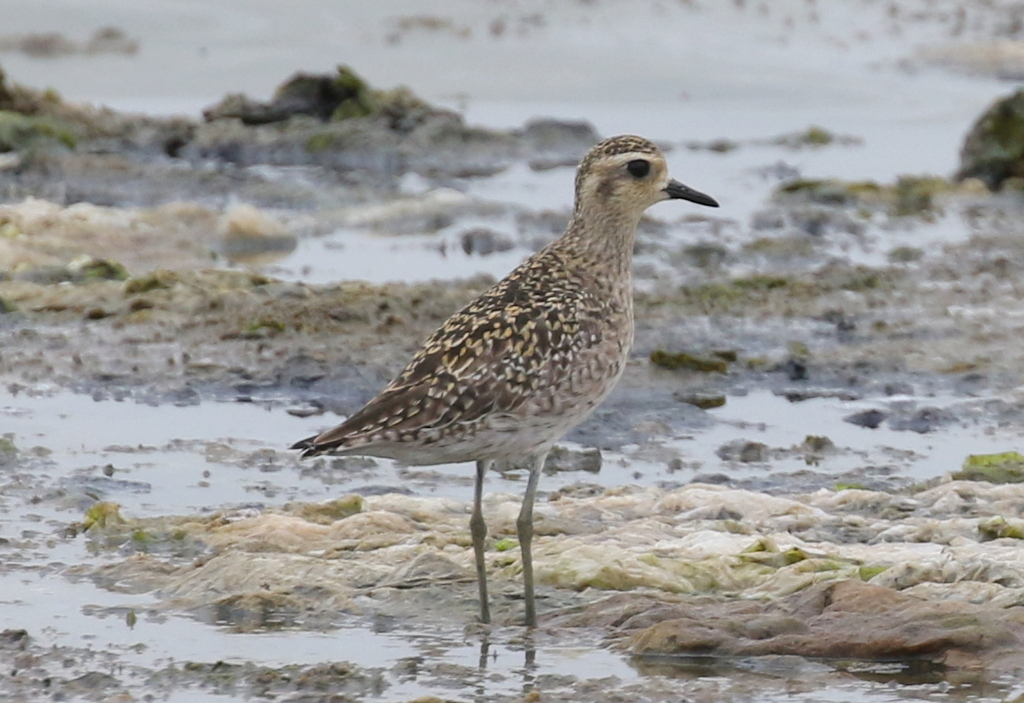
Having chatted though the ID, we knew that a flash of the underwing would confirm our suspicions, and with that the bird flew a short way with a group of Turnstones – now we had something to compare it directly to, we could see how small it was! But not only that, the underwing coverts were ash grey! At this point we opted to disembark and go for scope views, which we enjoyed for the next half hour or so. We saw it again in flight too, noting the projection of the toes beyond the tail tip and those underwings! It was a subtle and beautiful wader, and at the time of writing we think only the 7th record of Pacific Golden Plover for Greece.
It took a further twenty minutes to reach our lunch spot, overlook a series of islands occupied by a thriving colony of Mediterranean Gulls. The sound was quite impressive, with a hundred or more birds ‘kyowing!’ throughout our stop here – in fact it was hard to hear anything else! We manged to pull out a Red-throated Pipit going over though, and a singing Calandra Lark which posed distantly on the ground too.
Our main target bird here was Slender-billed Gull, and we had to accept fairly distant but acceptable views of two adults on the water. A Caspian Tern was a nice surprise though, flying past before joining a second bird and dropping into another group of Mediterranean Gulls and Sandwich Terns on one of the distant islets.
The remainder of the track from here to the Axios river was quiet, though we saw Hoopoe, Red-backed Shrike, Little Owl and a dombrowskii Yellow Wagtail. The next leg of the track north up the Axios embankment was the most heavily pot-holed of the lot, so progress was slow. This gave us plenty of time to spot more birds though! Many Wood Sandpipers, lovely close Spoonbills, a Purple Heron, rufous phase female Cuckoo and Garganey were all overshadowed by three stunning Spur-winged Plovers in perfect light just west of the bank. This was our main target for this area, and we found them in literally the last bit of suitable habitat along this stretch – very fortunate! Bumping our way out eventually to the main road, we then had about forty-five minutes driving north to our final site of the day.
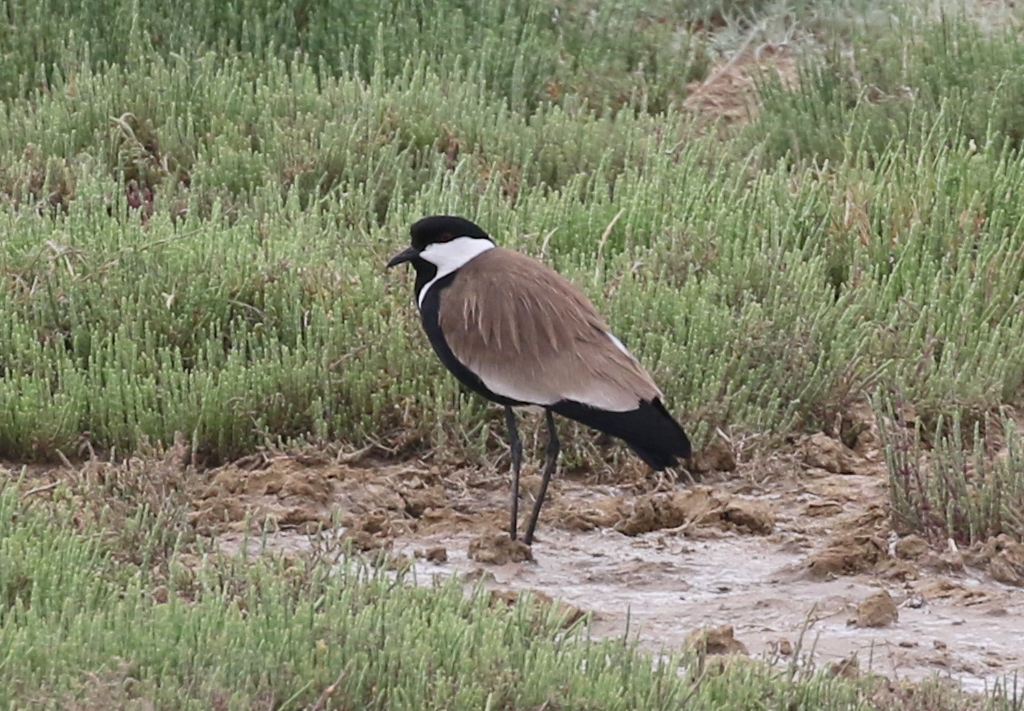
Its always nice to visit a new site on the tours, and our colleague Paul Roberts had recommended a small reservoir to us for the way back, near Polykastro. A singing Black-headed Bunting and male Red-backed Shrike as we approached the site were a good omen, and we loved the lush green habitat all around the reservoir which looked like a veritable haven to migrants.
It was a lovely temperature now, and the evening light was superb, and soon we were watching Collared Pratincoles hawking over the fields, and Great Reed Warblers croaking from the top of the reeds. In the distance, we could see a flock of about seven Lesser Kestrels hunting, and as we walked up the bank a flock of Whiskered Terns flew by.
Peering over carefully onto the water, the first bird that greeted us was a drake Ferruginous Duck! There were a dozen or more others on the reservoir, along with Tufted Duck, Common Pochard, Gadwall, Shoveler, Little and Black-necked Grebes and Garganey. Over the water were Common, Little, Black and White-winged Black Terns, and a Long-legged Buzzard flew by in the distance mobbed by a Hooded Crow. Another Lesser Grey Shrike was signing from the wires alongside the reservoir embankment here too.
It certainly was a delightful spot, and we ended the day scoping up to twenty five Collared Pratincoles, first on the ground and then sweeping back and forth over the cornfields. A breathless day with so many highlights, and the trip list now approaching 180 species!
FRIDAY 4TH MAY
Our quietest day of the trip so far, mainly due to the heat, but it is all relative – we still saw an awful lot of very good birds! We knew it was going to be a warm one, so opted for an early pre-breakfast excursion at 0630 up the hillside behind the village. After negotiating the network of very narrow streets, we found our way out to the eastern edge of the village where we parked up and set off on foot up the mountain track.
Winding our way up round the first couple of bends, the air was full of the song of Common Nightingale, Cirl Bunting and Woodchat Shrike – the latter being particularly common in this scrubby hillside habitat. Eastern Subalpine Warbler was also easy to see here, and we had some really great scope views of singing males – though we had still not seen a female on the trip!
Our main target bird for this site was Sombre Tit, one which is very easy to miss particularly at this time of year. We had some pretty decent views of a single bird, being pretty furtive and never perching in the open for long. In the end we were pretty satisfied with what we had seen, knowing this was likely our only chance on the trip to connect. Hoopoe, Levant Sparrowhawk and a superb female Eastern Orphean Warbler were also noted, the latter alarm calling to a Woodchat and grubbing around in the shrubs by the side of the track.
After breakfast, we called in briefly at the water trough, though things were definitely quieter here than in recent days – the local Red-backed Shrikes, Eastern Olivaceous Warblers and singing Black-headed Bunting supplemented by another good view of the male Levant Sparrowhawk, and a migrant Spotted Flycatcher.

Our plan for the rest of the morning was to travel down the western shore of the lake to Lithotopos, and on to Himarros where a track winds along the stream and up into the low forested hills. We saw two spectacular feeding frenzies on the lake as we drove along, of Dalmatian Pelicans and cormorants, but with a mission in mind we resisted the temptation to stop.
Reaching Himarros, a young Goshawk flew low over the track mobbed by Hooded Crows as we drove down, and we could also see two Short-toed Eagles and a Lesser Spotted Eagle soaring above the surrounding hillsides. It was already really hot here, and we knew we were going to struggle a bit – we certainly didn’t hear our main hoped for target, which was Olive Tree Warbler. It was right on the cusp for them arriving, and unfortunately we drew a blank on this occasion.

Eastern Subalpine Warbler and Red-backed Shrike were really common in the scrub here, the latter seen nest building and the males singing and calling all around. We glimpsed a Masked Shrike too, but the bird was really furtive and keeping to the deep shade inside thickets of bushes, and not wanting to come out.
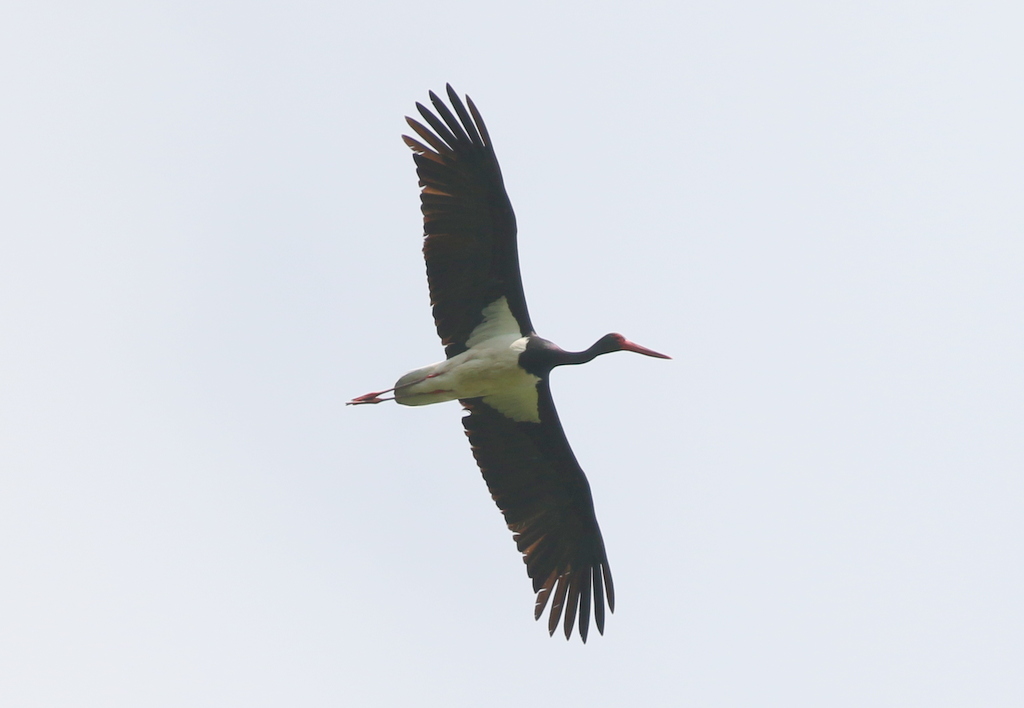
Overhead we did really well, with a Black Stork and another Goshawk seen circling above, later joined by two Lesser Spotted Eagles and a cracking Honey Buzzard which appeared low above us. Back in the shade of the riverside trees, we saw two Spotted Flycatchers, and then plenty of Bee-eaters as we made our way back out of the valley. A kettle of pelicans in a thermal above the valley contained both White and Dalmatian Pelicans, making for a nice comparison.

There were lots of other things to look at here – not just birds. We had good views of both Hermann’s and Spur-thighed Tortoise. A Stripe-necked Terrapin was crossing the track as we drove in and a Common Green Lizard was very obliging on the path. There were tons of butterflies too, including a good variety of fritillaries and lots of Little Tiger Blues. A Spoonwing (or Thread-winged Antlion) which flew across the path was particularly impressive.
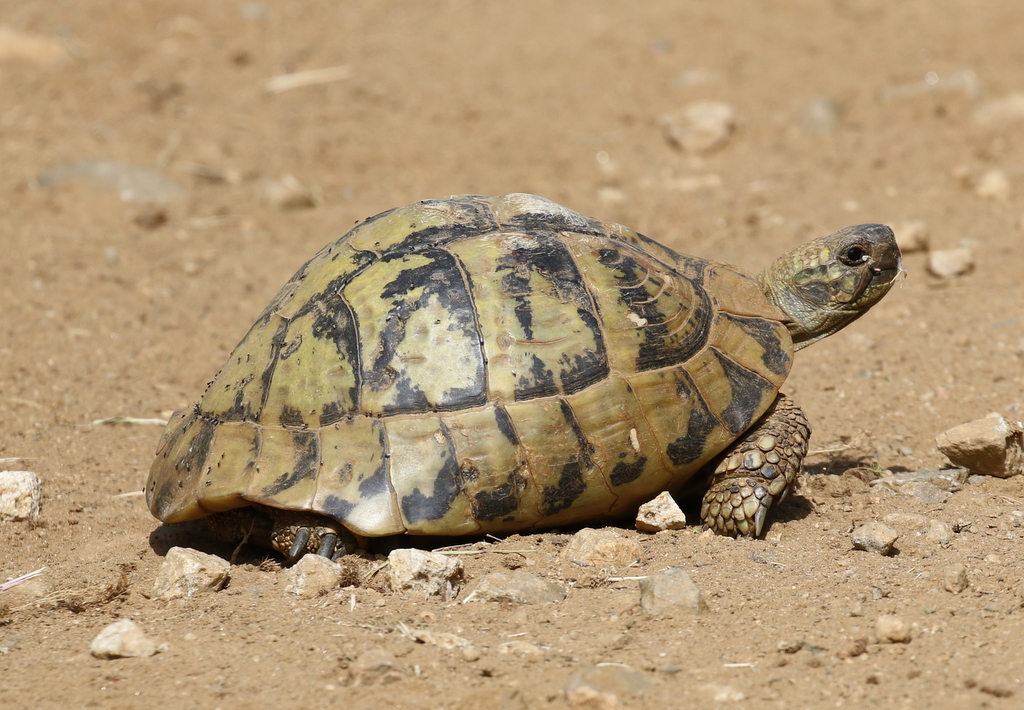
Deciding how to manage the hot part of the day was a tricky one, but we opted to head for higher ground in the hope of a cool breeze, and so decided to wind our way up the track above Neo Petritsi village to the Bulgarian border. About 7km up, we stopped for lunch looking back over the forest – a Short-toed Eagle was hanging on the wind above us and gave superb views, while we also had more opportunities to study Honey Buzzard with one circling up right in front of us. As it folded its wings and made a stoop, we realised there was an interloper in its territory – a moulting female Goshawk which circled round once before dropping out of view.
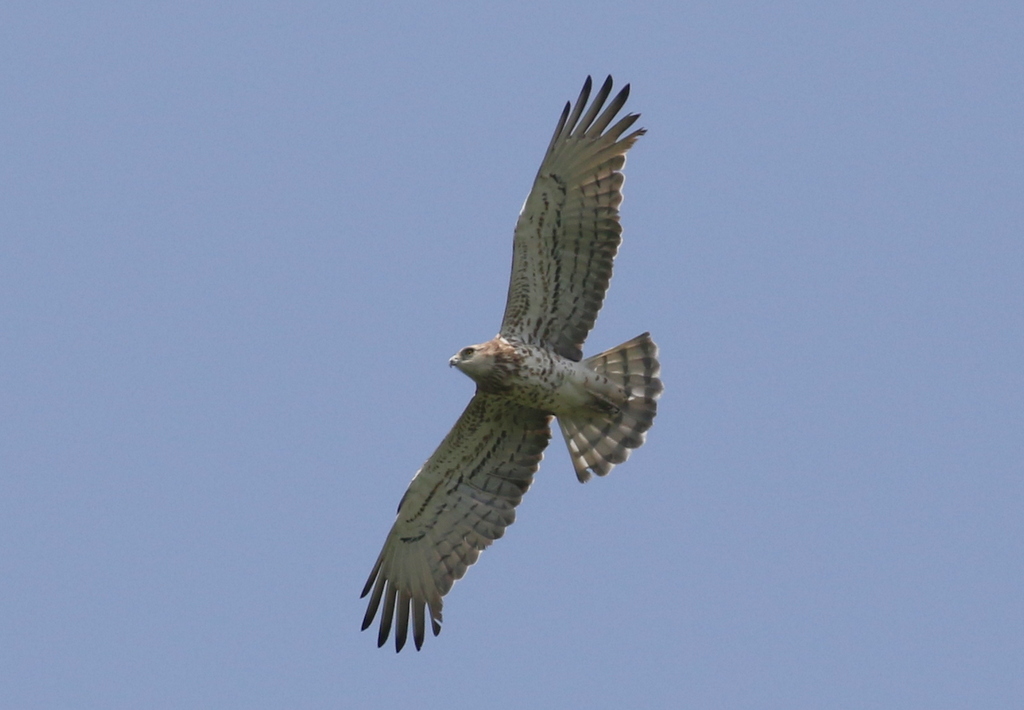
As we climbed higher, a further 6km to the border post, the road passed through delightful beech woodland resounding to the songs of Blackcap and Robin! What we were not expecting though, was a Wildcat running up the road in front of us. The animal dived off into the undergrowth down a steep bank, and by quickly bailing out of the van we saw it again running off through the undergrowth, but that was it – a sighting based purely on chance.
Nearing the border, we parked and took a walk along the ridge for about 1km, passing through more nice forest of the way – we kept an ear open for White-backed Woodpecker, but no such luck! There were very few birds around at this elevation, but two Short-toed Eagles showed really well, and a pair of Hawfinch flew low over calling.
Back down at ground level, and we popped into the Strimon marshes for a quick look. The pools were holding a fair bit of water, and we found several Wood Sandpipers, Black-headed Wagtail, Little Ringed Plover and two Temminck’s Stints here. More impressive though, was a feeding frenzy of over thirty Grey Herons, 26 Spoonbills and 9 Black Storks, catching small fish in the dwindling puddles. Red-backed Shrike and Black-headed Bunting were also around – every stop seemed capable of producing a haul of decent birds!
Our last hour or so of the day would be spent on the eastern embankment of Lake Kerkini, and despite the tricky light at this time of day we saw a load of birds. Bee-eaters and Hoopoe were looking stunning on the east side of the bank, illuminated by the evening light, and we had a lovely Lesser Grey Shrike perched up too. The water level had risen considerably since our first visit here, and many of the same species were present – Spoonbills, Glossy Ibises, Great White and Cattle Egrets, flocks of Wood Sandpipers and distant Whiskered Terns. Temminck’s Stint, six Curlew Sandpipers and a fine Marsh Sandpiper were new in though, replacing the scores of Squacco Herons present previously which were now conspicuous by their absence.
Heading back towards Megalachori, a stunning adult Purple Heron was fishing in the open, with a second bird among the reeds where we searched in vain for Little Bittern and Little Crake, without success. Unbelievably, it was now almost 7pm – we had to tear ourselves away! As had been typical for the trip as a whole, there was time for one more good bird – a gorgeous female Red-footed Falcon circling over the road by the drinking trough on the way back to base. After initially only being seen drifting away, the bird thankfully turned and circled right back over us, putting the tin lid on our last day in the field.
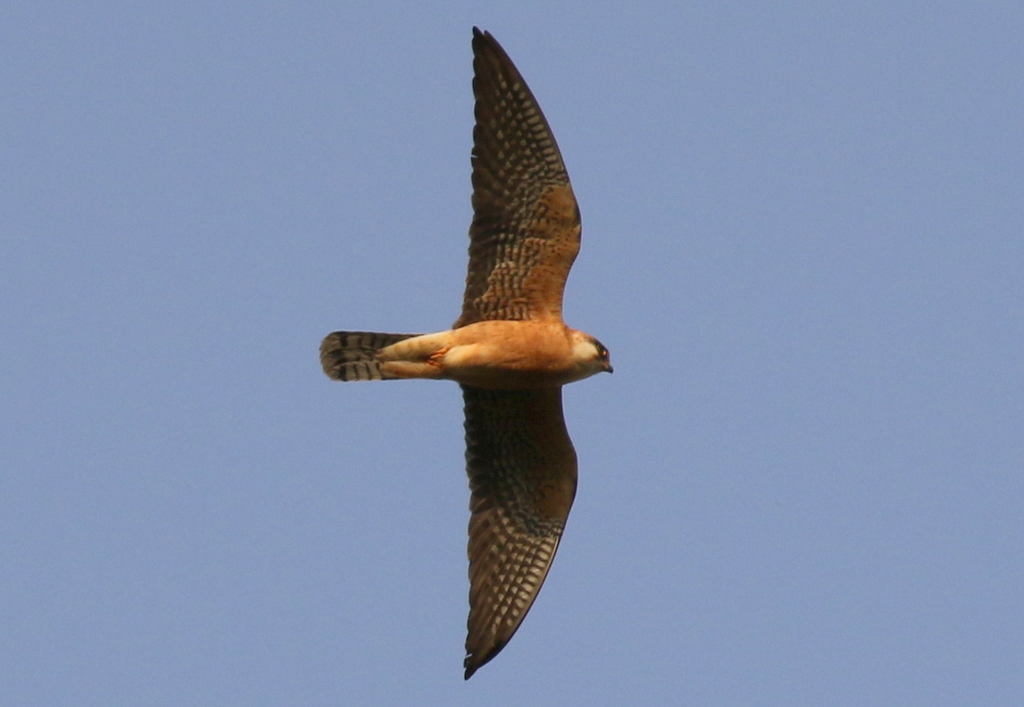
SATURDAY 5TH MAY
A seamless transition was enjoyed back to Thessaloniki this morning, with a few birds seen from the motorway en route such as Roller, Masked Shrike, a couple of Black-headed Buntings and two Ring-necked Parakeets! We dropped the vans off at the hire car depot at 0930 as planned, and despite leaving a little late from Thessaloniki, were back in London pretty much on schedule at 1330.
It had been a great seven days in Greece – the weather was warm and sunny, there were lots of fantastic birds and a great selection of other wildlife too. We didn’t want to leave! The good news is that we will be going back again in 2019 – provisionally on 28th April to 4th May. If you like the sound of this year’s trip and might be tempted to join us, please let us know…
















